I spent my Tuesday night at an author reception/book signing and 2 hour “Herbal Kitchen” class with author Kami McBride from The Living Awareness Institute.
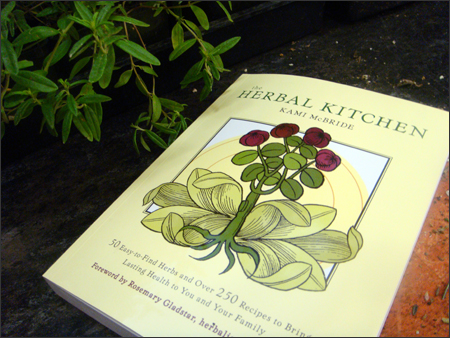
The Herbal Kitchen: 50 Easy-to-Find Herbs and Over 250 Recipes to Bring Lasting Health to You and Your Family.
I saw the class advertised in the co-op catalog a few months back and it looked interesting. I asked myself the question…What do you know about herbs? My answer was – not much. I knew that they flavor my food. I knew that most recipes call for them… but what fascinated me after taking the class was finding out that they could do so much more and they serve a purpose much deeper than “adding flavor”.
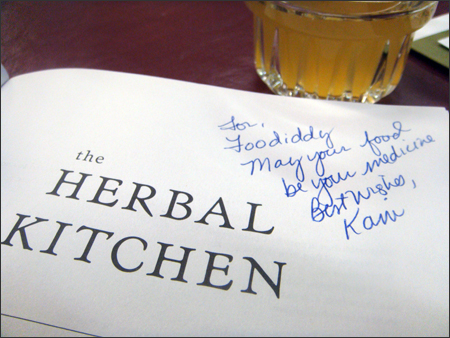
Everyone in class raised their hand when asked if they used herbs for flavor in cooking. I think Kami’s goal was to help us realize how powerful herbs can be. What really struck me was when she mentioned that herbs are the bridge to the bodies ability to digest. How cool is that?
Chemicals in our pre-packaged foods have taken over and they are zapping our bodies of energy and causing an epidemic of chronic digestive issues – even in children. Kami talked about processed foods becoming a burden to our bodies instead of a source of vitality. Getting back to eating real foods has been my own personal goal and this class just reiterated how important it really is.
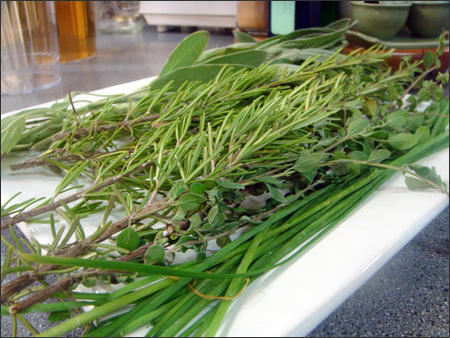
I went away from the class with some goals. The first was to continue making my own salad dressing. Sure, I have 2 favorite store bought dressings, Miso and Champagne – but I’m already on the search for recipes to help me re-create those in my own kitchen. The Herbal Kitchen book has pages and pages of wonderful salad dressing recipes and herb salad sprinkle options.
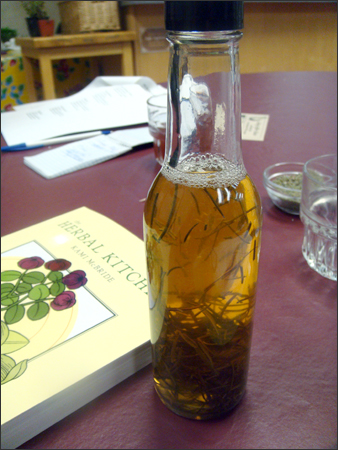
Lavender Rosemary Vinegar was one of the items created that evening. I would never have thought to add dried lavender to vinegar. We learned that you always want to use dry herbs in your herbal vinegars and oils. Fresh herbs will bring mold into the mix. Yuck to that.
Kami recommended using organic/cold pressed olive oil. Since I’ve never dried my own herbs, I was interested in the process. Seemed pretty simple. You use a woven basket or screen to lay your fresh herbs on and you just let them air dry. In the summer months here in Sacramento, CA – the process happens in less than an hour – in the winter months, it could take up to a day. You can then place the dried herbs in jars.
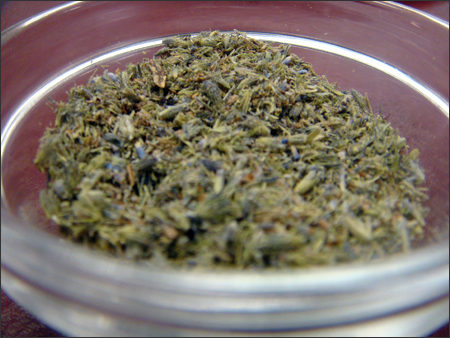
Speaking of jars… we watched Kami make powdered spices with the Oster blender. I had no idea that the base of the blender fits perfectly on a Bell canning jar. She put some dried lavender sprigs into the bell jar, put the Oster base onto the jar, flipped the jar upside down and blended away – can’t wait to try that with some dried herbs of my own.
We also discussed honey. She talked about many different herbal honey recipes and how easy it is to get more herbs into your body through herbal honeys. Adding them to your oatmeal, warm cereal grains, tea, toast, waffles, salad dressings, sauces, beverages, etc. My questions was – What kind of honey should I buy? I pretty much knew the answer was going to be “local” and that it probably didn’t include the words “plastic bear” – I was right – Local, raw honey. She talked about the raw honey being full of enzymes. Those enzymes are destroyed during the heating process – so finding honey that has never been heated is key. I must check out the local farmers market, I’m running low.

We got to taste Kami’s recipe for curried honey. The recipe included powdered turmeric, coriander, cumin, ginger, fennel seed and a bunch of other spices. She suggested using it on baked chicken, pretty sure that would taste amazing. The herbal honey acts as a digestive aid with the added fennel and ginger. As for shelf life, honey remains stable for 2-3 years after adding dried herbs to it.
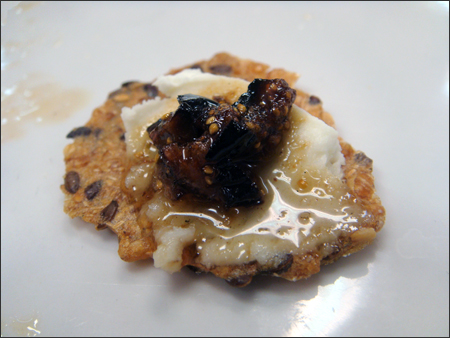
We also sampled Mary’s Gone Crackers (Original Seed Cracker) with organic goat cheese, and ginger fig honey. They were awesome! The ginger fig honey used some star anise powder – I learned that star anise is a powerful carminative antioxidant.
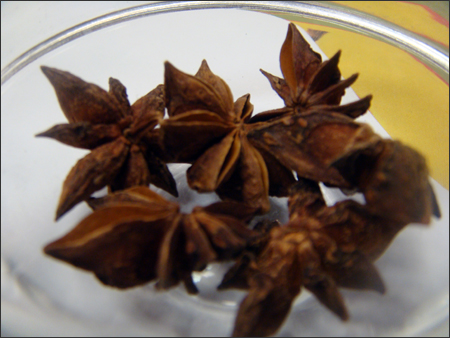
The warming spice helps with gas and bloating and one star anise is enough to flavor an entire soup pot. Powerful stuff.
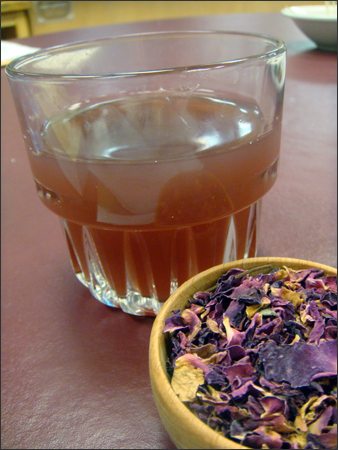
Another take away item from the class was the need to eliminate all soda from your diet. Diet soda, regular soda… there are many healthier options available. We sipped on a Party Punch and Lemon Verbena Lemonade during the class and they were wonderful. A sample of drink recipes from The Herbal Kitchen can be found on the Living Awareness website. Most are as simple as combining herbed tea with juices. We passed around lemon verbena branches and the smell was out of this world. I would definitely like to grow my own lemon verbena.

We learned that chives, garlic and onion can all be used for cold and flu prevention. Oregano and Sage were also mentioned in the same category. I have thumbed through the book and continue to be fascinated to read about the history, lore and uses for herbs.

It was pointed out that creating a special place for herbs on the table is a key step to actually using them. It was mentioned that so many people store them away in the cabinet or only use herbs and spices in special recipes – mustard seed once a year for corned beef and cabbage on St. Patrick’s Day, cloves for pumpkin pie or ham, Sage for use with turkey on Thanksgiving. The average life of spices left out on your kitchen counter in a spice rack is about 6 months. If stored in the dark cabinet, longer – but people hang onto them for years and years, when we all should be using them daily. 6 months is plenty of time to use entire jars of spices. She kept saying over and over – use your spices!
Kami was very proud of her lazy susan of spices – particularly her paprika frogs – she suggested fun containers to jazz things up. We talked a lot about paprika and it’s ability to reduce inflammation on capillary vein walls. We made a paprika oil with coconut oil and she suggested using that on corn and other veggies. I actually have coconut oil, so I felt pretty proud of that, LOL. Her entire family uses the lazy susan – her kids get excited to use cinnamon, paprika and her other pre-mixed spice combinations.
We also talked about Ghee and it’s use. I had no clue – didn’t know what ghee was. Ghee is butter that is heated in order to separate the water and milk solids from the butter fat. It’s more stable than olive oil and great for people that are lactose intolerant. You can also buy it in stores – it’s clarified butter. She showed us an organic version. You can flavor your ghee with herbs and spices – we got to taste a powdered cinnamon, allspice and clove ghee – perfect for toast. I learned that cloves are a very strong carminative – clove helps your sinuses and mucus drainage – yum. We then had a discussion about how dairy products produce extra mucus and phlegm – causing people the need to clear their throats after eating meals high in fat/dairy. Spiced tea is a good way to end a meal to help with that.
One of the last things of the night was a recipe for Arugula Sage Pesto. There was an over-salting issue, but we still got to try a doctored version and it was super tasty!
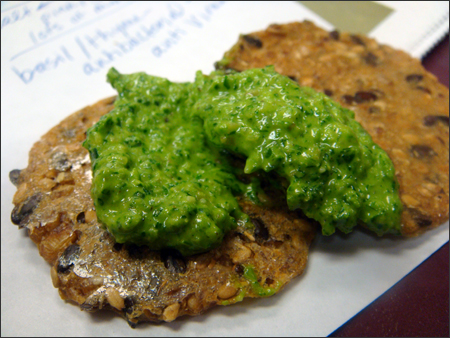
There are a few pesto recipes on Kami’s website. I’m looking forward to trying a few from the book on veggie and regular pasta or pizza.
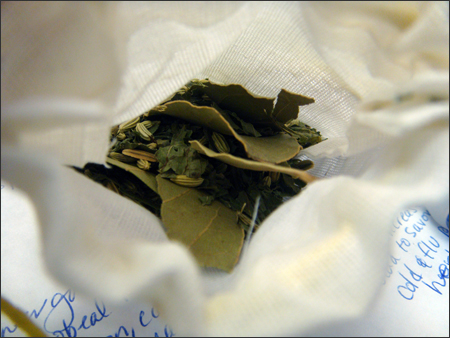
Our takeaway gift was a soup bouquet filled with dried parsley, lemon balm (part of the mint family), dried fennel seed, bay leaf and anise pod.
I learned a lot and look forward to reading the book to learn more. Right now my favorite fresh herbs are thyme, oregano, basil and dill – I’d like to incorporate so many more into my daily eats.
Do you have a favorite spice/herb? Do you grow your own? Did this post make you roll your eyes? 😉
Truth be told, I feel empowered. I feel armed with knowledge and Dan is never going to know that I’ve ramped up my herb usage – I’m going to sneak them in everywhere – especially now during cold and flu season.
![]()

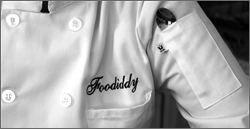

6 comments
2 pings
Skip to comment form
I would love to take a class like this. I use dried herbs all the time in cooking … and I actually run out of things fairly regularly. (I sing the praises of Penzey’s Spices – you have to try them!) As far as tea goes, a wonderful spiced tea (caffeine free) that I drink a lot of is Good Earth. Have you tried it? It’s great hot or cold…if you haven’t tried it, let me know and I’ll send you some tea bags.
Very interesting. Loved your post today. I don’t know much about herbs at all. Only that they’re in little jars in a spice cabinet that you use in certain recipe’s. And, like you, I use the same ones all the time. Interesting, also, is the fact that they should be changed every 6 months!!
ooohhhhh… the books sounds like a must for any kitchen.
I’ll need to add that to my christmas wish list… as well as that veggie slicer that I have yet to find!
Author
I think you should go with Amazon for the slicer, I haven’t seen it anywhere else either. It’s been a week for me, I’m about to bust it out for today’s lunch…I honestly love the thing!
I just stumbled across your blog via Emily at The Front Burner and I loved this post! There’s so much more to eating whole foods than carrots, apples and spinach–I’m anxious to get a copy of this book and to begin incorporating more spices into my daily meals. 🙂
-Lisa
Man, really want to know how can you be that smart, lol…great read, thanks.
[…] tonight for Kari McBride’s The Herbal Kitchen. I heard about the book via Kathleen’s Foodiddy blog and she went to a similar book signing/class up in Sacramento a few weeks ago. When I checked out […]
[…] class by Kami McBride, author of The Herbal Kitchen–I found out about Kami and the event from Kathleen at Foodiddy and I promised to write a follow-up to the event. I realized today how much time had passed since […]